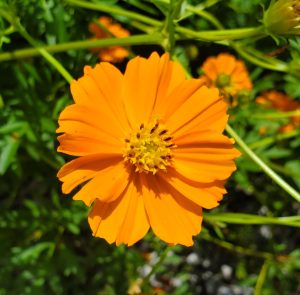Being in Southwest Florida in more or less Hardiness Zone 10a, we have some wiggle room that other parts of Florida north of us do not enjoy. Some of this leeway involves being able to grow annuals in fall without too much fear of freezing temperatures as “winter” approaches. If you are thinking about annual flowers, one that I really like is the annual known as cosmos. This flowering plant comes in many sizes, shapes, and colors which makes it a favorite of many gardeners. Originally from the Mexico, cosmos are not only sun-lovers, but also do well in our sandy, low fertility, soils.
One very familiar cosmos available in seed catalogs and local garden centers is called the Sensation-type cosmos or Cosmos bipinnatus. This cosmos can grow from three to six feet in height and has fine thread-like leaves and flowers in shades of lavender, white, red, pink, rose and violet. Cosmos plants tend to be very open and sprawling with weak stems that sometimes need support in the form of stakes. A bit floppy, the primary usage of Sensation-type cosmos are its exquisite blooms which make excellent cut flowers lasting in arrangements for seven to ten days. Because of their height and relatively weak nature, early pinching can help somewhat to promote a bushier and denser plant. Deadheading old flowers before seeds develop can go hand-in-hand with keeping plants rejuvenated for more rounds of blooms. Another species of cosmos, Cosmos sulphureus is also readily available. Also called the yellow cosmos, it has orange and yellow flowers. The foliage of this cosmos has more of a feather-like appearance than the previously mentioned species. Keep in mind that there are dwarf varieties of both species available which will fit better as bedding plants. Check on-line mail order gardening sites for selections and descriptions of these smaller scale cultivars.

While you may be able to find some started plants at local garden centers, I most often locate seed packs of selected cosmos to start my own plants. Cosmos plants are extremely easy to start from seed either as transplants or planted directly from seed just where you want them. In fact, cosmos seeds are often found in wildflower mixes, and, in some communities, I have seen them planted along highways in colorful drifts of assorted pink, lavender and white colors. Cosmos can reseed themselves and this makes them ideal for those looking to establish a “mini meadow” in undisturbed areas of your yard. The site you select for your cosmos planting should be in full sun; well-drained, but of low fertility. Too much fertilizer will actually cause the plant to produce abundant foliage at the expense of flowers. Cosmos seeds will germinate in as little as one week. From seed to the first bloom, cosmos will take from eight to twelve weeks. Plant or thin cosmos to about eighteen inches apart for best growth. You will generally get a three-month period of bloom before needing to remove the old plants and start more of these faithful annuals.

With bright and easy-to-grow flowers and ability to thrive in difficult growing conditions, all types of cosmos belong in your garden! For information on common flowering annuals and perennials suitable for growing in our area, or to ask a question, you can also call the Master Gardener Volunteer Helpdesk on Mondays, Wednesdays, and Fridays from 1 to 4 pm at 764-4340 for gardening help and insight into their role as an Extension volunteer. Ralph E. Mitchell is the Director/Horticulture Agent for UF/IFAS Extension – Charlotte County. He can be reached at 941-764-4344 or ralph.mitchell@charlottecountyfl.gov. Connect with us on social media. Like us on Facebook @CharlotteCountyExtension and follow us on Instagram @ifascharco.
Resources:
Gilman, E. F., Klein, R. W. & Hansen, G. (2023) Cosmos bipinnatus ‘Sonata White’, Mexican Aster. The University of Florida Extension Service, IFAS.
Gilman, E. F. & Howe, T. (1999) Cosmos bipinnatus. The University of Florida Extension Service, IFAS.
Gilman, E. F. & Howe, T. (1999) Cosmos sulphureus. The University of Florida Extension Service, IFAS.
Brown, S. P. (2021) Gardening with Annuals in Florida. The University of Florida Extension Service, IFAS.
Cotner, S., Parsons, J., Johnson, J. & Cole, C. Cosmos Produces Cosmic Beauty. Texas AgriLife Extension Service, Texas A&M System.
Barkley, D. (2024) Cosmos Brings Beauty to Your Universe. NC Extension Service.
 1
1
